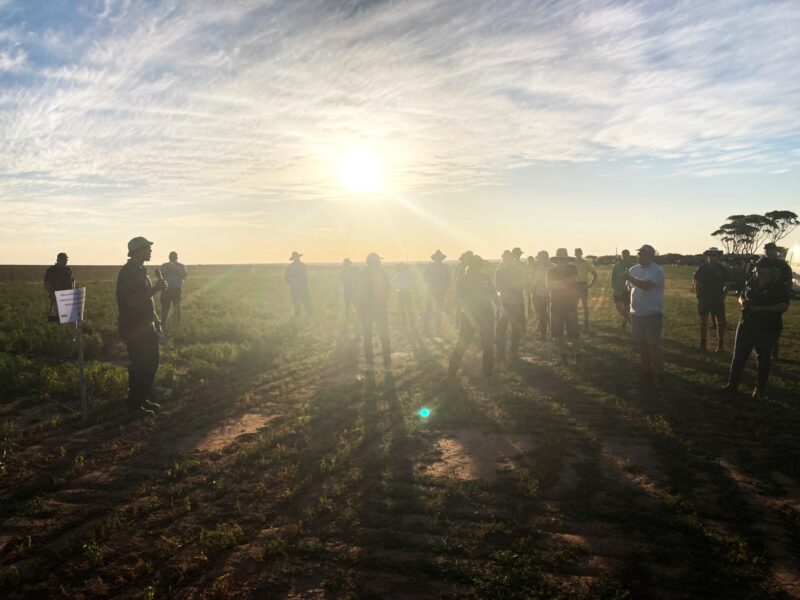Calcareous soils: What we’ve learnt in 2 years
Highly calcareous soils are important in some areas of south-eastern Australia and challenge crop production with a range of constraints. The project, “More profitable crops on highly calcareous soils by improving early vigour and overcoming soil constraints”, supported by the CRC for High Performance Soils and GRDC, sought to identify and overcome constraints on these difficult soils in order to improve crop production. This was achieved through a multi-disciplinary team of researchers from SARDI, CSIRO and NSW DPI.
Since its inception in 2020, a holistic approach to addressing these constraints to crop productivity and profitability was implemented to better understand:
- The benefits of organic matter and extra nutrient inputs on crop health and growth
- The impacts of a range of amendments on subsoil properties typical of calcarosols
- The contribution of novel approaches (carbon coated minerals – CCM (formerly bespoke biochar) to P supply, crop vigour and root health
- Current issues with crop emergence and fertiliser toxicity under marginal moisture conditions, and
- The impact of high soil strength and the contribution of a physical intervention to ameliorate compaction.
Outcomes
- Crops growing on a mildly calcareous soil were less responsive to the strategies investigated than those on highly calcareous soils of upper EP.
- Short-term topsoil strategies resulted in better gains in crop biomass and yield when compared to longer-term subsoil strategies.
- Higher seeding rates and adequate nutrition at sowing was effective at achieving high plant densities, crop biomass and grain yield.
- CCM in the topsoil improved cereal crop vigour, biomass and grain yield as well as providing good benefits into the second crop.
- High soil strength is an issue in calcareous soils, however, positive responses to deep ripping are less likely and usually limited by the hostile subsoil.
Implications to industry
Cereal crop responses to the more costly subsoil strategies were smaller and less likely in highly calcareous soils with underlying physical, biological, and chemical constraints. Ameliorating high soil strength by deep ripping has proven to be less effective on these types of soils than on other sands. The incorporation of organic amendments (pelleted chicken manure, CCM) into subsoils has shown potential to improve crop production but is still economically dubious. However, this response needs to be validated over more situations to determine their general impact on longer-term crop productivity and profitability.
Plant population, crop biomass and grain yield were improved by higher sowing rates, providing that the denser plant populations are supported by improved nutrition (N and P and trace elements). CCM boosted crop vigour and biomass production when placed just below the seed. We suggest that at least part of the benefits from this CCM is to deliver P to the crop in a more effective way than current mineral fertilisers. Residual benefits of CCM were evident, however, further investigation is needed to determine how best to apply CCM and how low they can be applied to improve crop growth, productivity, and overall farm profitability.
Key recommendations after two years of results are:
- Crop responses to the more costly subsoil strategies are smaller and less likely in highly calcareous soils with underlying physical, biological and chemical constraints. Therefore, the focus should be on short-term topsoil strategies to improve early crop vigour, biomass and grain yield.
- The use of higher sowing rates is an effective strategy to improve plant population, crop biomass and grain yield, providing that the denser plant populations are supported by improved nutrition (N and P and trace elements).
- Carbon-coated minerals placed just below the seed is another effective strategy to improve early crop vigour, biomass and grain yield. Residual benefits were very good. Further investigations are needed to fully define their residual benefits, determine how best to apply them and how low they can be applied to improve crop growth and productivity. This product is not commercially available.
- Ameliorating high soil strength by deep ripping has proven to be less effective on these types of soils than on other sands, therefore the recommendation is to identify and understand the underlying subsoil constraints before making the decision to deep rip.
Addressing multiple constraints in calcareous soils using integrated solutions will ensure an increase in crop productivity and subsequently profitable and sustainable farming systems.
Acknowledgements
This project, “More profitable crops on highly calcareous soils by improving early vigour and overcoming soil constraints” is supported by the Cooperative Research Centre for High Performance Soils whose activities are funded by the Australian Government’s Cooperative Research Centre Program and GRDC, and SAGIT and AIR EP as project partners. The authors would also like to thank the landholders and families involved in this project: Shard Gosling, Simon Guerin and the Minnipa Agricultural Centre.
For more information, please contact:
Brian Dzoma (SARDI)
Email: brian.dzoma@sa.gov.au

Brian presenting the calcareous soil trial site at Minnipa Ag Centre Field Day, September 2023